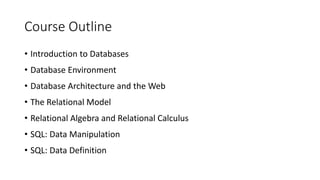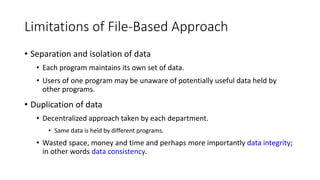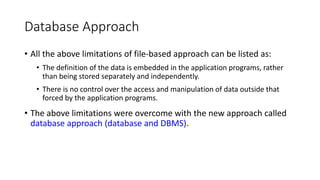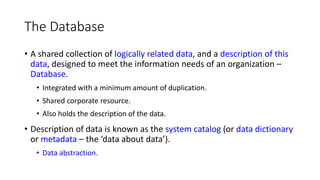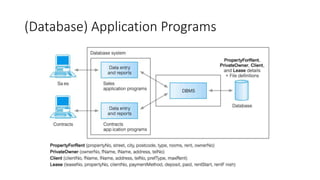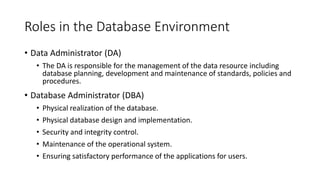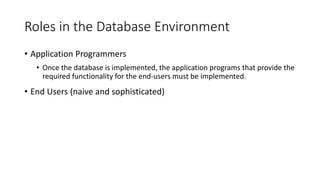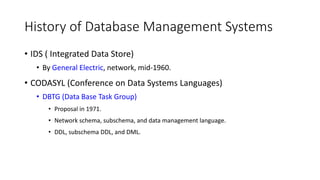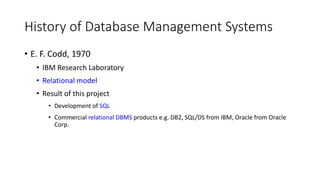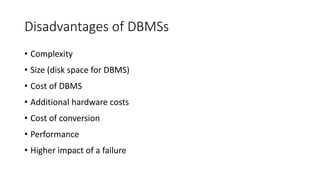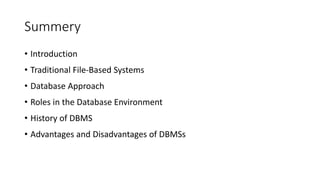CS3270 - DATABASE SYSTEM - Lecture (1)
- 1. CS3270 DATABASE – I Mr. Dilawar Lecturer, Computer Science Faculty, Bakhtar University Kabul, Afghanistan.
- 2. Course Objectives After successfully completing this course, you will be able to: • Understand the underlying concepts of database, and database management system (DBMS). • Learn the concept of relational data model. • Analysis and design of database application or information system. • Experience with SQL. • Implement the database using SQL. • Learn to work with Microsoft SQL Server environment.
- 3. Course Outline • Introduction to Databases • Database Environment • Database Architecture and the Web • The Relational Model • Relational Algebra and Relational Calculus • SQL: Data Manipulation • SQL: Data Definition
- 4. Course Outline • Database Planning, Design, and Administration • Fact-Finding Techniques • Entity-Relationship Modeling • Enhanced Entity-Relationship Modeling • Normalization • Advanced Normalization • Design Methodologies
- 5. Text Books to Follow • Database Systems: A Practical Approach to Design, Implementation, and Management, Connolly, T. M., and Begg, C. E. 6th Edition, Addison Wesley, 2015. • Modern Database Management, Hoffer, Jeffrey A., and Prescott, Mary B., and McFadden, Fred R. 10th Edition, Prentice Hall, 2011. • Database Processing Fundamentals, Design and Implementation, Kroenke, David M. 12th Edition, Prentice Hall. • An Introduction to Database Systems, Date, C. J. 8th Edition, Addison Wesley, 2003.
- 7. Lecture Outline • Introduction • Traditional File-Based Systems • Database Approach • Roles in the Database Environment • History of DBMS • Advantages and Disadvantages of DBMSs
- 8. Introduction • Collection of logically related data is called database. • A database may be of any size and complexity. • Salesperson may contain a small database of customer contacts. • A large corporation may build a large database.
- 9. Introduction • Other examples of database applications can be: • Purchases from the supermarket. • Purchasing using your credit card. • Booking a holiday at the travel agent. • Using the local library. • Using the internet. • Studying at university.
- 10. Introduction • A software or tool that is used to manage and control the access to the database is called database management systems. • A database application is simply a program that interacts with the database at some point in its execution. • A database system is a collection of application programs that interact with the database along with the DBMS and database itself.
- 11. Traditional File Processing System • File-based system is a collection of application programs that perform services for the end-users such as the production of reports. • Each program defines and manages its own data. • Early attempt to computerize the manual filing system. • Files in cabinet and locks for security. • For searching we may have indexing system that helps locate what we want quickly. • Works well • While number of items to be stored is small. • For only storage or retrieval functionality of large number of items.
- 12. Traditional File Processing System • The manual system becomes more inefficient while processing the information in the files. • Typical real estate agent’s office holds two separate files: • File for each property for sale or rent. • File for each buyer and renter, and each member of staff.
- 13. Traditional File Processing System Sales Department Contract Department
- 14. Traditional File Processing System • Consider the efforts that would be required to answer the following questions:
- 15. File-Based Approach • The file-based system was developed in response to the needs of industry for more efficient data access. • Based on decentralized approach, where each department, with the assistance of Data Processing (DP) staff, stored and controlled its own data. • Consider the DreamHome example.
- 17. File-Based Approach • Significant amount of duplication of data. • Before to discuss the limitations, it is useful to understand the terminology used in file-based systems. • A file is simply a collection of records, which contains logically related data. • For example, the PropertyForRent file contains six records, one for each property. • Each record contains a logically connected set of one or more fields. • Each field represents some characteristics of the real-world object that is being modeled.
- 18. Limitations of File-Based Approach • Separation and isolation of data • Each program maintains its own set of data. • Users of one program may be unaware of potentially useful data held by other programs. • Duplication of data • Decentralized approach taken by each department. • Same data is held by different programs. • Wasted space, money and time and perhaps more importantly data integrity; in other words data consistency.
- 19. Limitations of File-Based Approach • Data Dependence • File structure is defined in the program code. • Also known as a Program-Data dependence. • Incompatible file formats • Programs are written in different languages, and so cannot easily access each other’s files. • Fixed Queries/Proliferation of application programs • Programs are written to satisfy particular functions. • Any new requirement needs a new program.
- 20. Database Approach • All the above limitations of file-based approach can be listed as: • The definition of the data is embedded in the application programs, rather than being stored separately and independently. • There is no control over the access and manipulation of data outside that forced by the application programs. • The above limitations were overcome with the new approach called database approach (database and DBMS).
- 21. The Database • A shared collection of logically related data, and a description of this data, designed to meet the information needs of an organization – Database. • Integrated with a minimum amount of duplication. • Shared corporate resource. • Also holds the description of the data. • Description of data is known as the system catalog (or data dictionary or metadata – the ‘data about data’). • Data abstraction.
- 22. Database Management System • A software system that enables users to define, create, maintain, and control access to the database. • The DBMS is the software that interacts with the users’ application programs and the database.
- 23. Database Management System • Typically, a DBMS provides the following facilities: • It allows users to define the database, usually through a Data Definition Language. • The DDL allows users to specify the data types and structures and the constraints on the data to be stored in the database. • It allows users to insert, update, delete, and retrieve data from the database, usually through Data Manipulation Language (DML). • It provides controlled access to the database. • Data security, data integrity, concurrency control system, recovery control system, and a user-accessible catalog.
- 24. (Database) Application Programs • A computer program that interacts with the database by issuing an appropriate request (typically an SQL statement) to the DBMS. • The programs might be a desktop application or an online application. • The application program may be written in some programming languages or in some 4GL.
- 26. (Database) Application Programs • Allows each user to have his or her own view of the database – View. • A view is essentially some subset of the database. • The benefits of views are: • Reduce complexity. • Provide a level of security. • Provide a mechanism to customize the appearance of the database. • Present a consistent, unchanging picture of the structure of the database, even if the underlying database is changed.
- 27. Components of the DBMS Environment
- 28. Roles in the Database Environment • Data Administrator (DA) • The DA is responsible for the management of the data resource including database planning, development and maintenance of standards, policies and procedures. • Database Administrator (DBA) • Physical realization of the database. • Physical database design and implementation. • Security and integrity control. • Maintenance of the operational system. • Ensuring satisfactory performance of the applications for users.
- 29. Roles in the Database Environment • Database Designers (Logical and Physical) • The logical database designer must have a thorough and complete understanding of the organization’s data and any constraints on this data. • Identifying the data (entities, attributes, relationships, and constraints). • Constraints are some called business rules.
- 30. Roles in the Database Environment • Database Designers (Logical and Physical) • The physical database designer decides how the logical database design is to be physically realized. • Mapping the logical database design into a set of tables and integrity constraints. • Selecting specific storage structures and access methods for the data to achieve good performance. • Designing any security measures required on the data.
- 31. Roles in the Database Environment • Application Programmers • Once the database is implemented, the application programs that provide the required functionality for the end-users must be implemented. • End Users (naive and sophisticated)
- 32. History of Database Management Systems • Roots of the DBMS • Apollo moon-landing project, 1960s. • NAA (North American Aviation), prime contractor for the project. • Developed a software GUAM (Generalized Update Access Method), hierarchical. • In mid – 1960s IBM joined NAA, result was IMS (Information Management System).
- 33. History of Database Management Systems • IDS ( Integrated Data Store) • By General Electric, network, mid-1960. • CODASYL (Conference on Data Systems Languages) • DBTG (Data Base Task Group) • Proposal in 1971. • Network schema, subschema, and data management language. • DDL, subschema DDL, and DML.
- 34. History of Database Management Systems • E. F. Codd, 1970 • IBM Research Laboratory • Relational model • Result of this project • Development of SQL • Commercial relational DBMS products e.g. DB2, SQL/DS from IBM, Oracle from Oracle Corp.
- 35. Advantages of DBMSs • Control of data redundancy • Data consistency • More information from the same amount of data • Sharing of data • Improved data integrity (constraints) • Improved security (authentication, rights) • Enforcement of standards (data formats, naming conventions, documentation etc.)
- 36. Advantages of DBMSs • Economy of scale (economical cost) • Balance conflicting requirements • Improved data accessibility and responsiveness (ad hoc queries) • Increased productivity (developer) • Improved maintenance through data independence • Increased concurrency • Improved backup and recovery services
- 37. Disadvantages of DBMSs • Complexity • Size (disk space for DBMS) • Cost of DBMS • Additional hardware costs • Cost of conversion • Performance • Higher impact of a failure
- 38. Summery • Introduction • Traditional File-Based Systems • Database Approach • Roles in the Database Environment • History of DBMS • Advantages and Disadvantages of DBMSs
- 39. Thank You For your Patience
Editor's Notes
- #16: Well-organized
- #19: List of all houses that match the requirements of clients, first temporary file who have house as the preferred type. Consistency means realiblity.
- #22: data abstraction, is that we can change the internal definition of an object without affecting the users of the object, provided the external definition remains the same. Logically related data comprises entities, attributes, and relationships of an organization’s information – Database.
- #24: a concurrency control system, which allows shared access of the database.
- #28: Hardware: The DBMS and the applications require hardware to run. The hardware can range from a single personal computer, to a single mainframe, to a network of computers. Software The software component comprises the DBMS software itself and the application programs, together with the operating system, including network software if the DBMS is being used over a network. Data Perhaps the most important component of the DBMS environment, certainly from the end-users’ point of view, is the data. The database contains both the operational data and the metadata, the ‘data about data’. The structure of the database is called the schema. Procedure Procedures refer to the instructions and rules that govern the design and use of the database. Log on to the DBMS. Use a particular DBMS facility or application program. Start and stop the DBMS. Make backup copies of the database. People: The final component is the people involved with the system.
- #30: We split the work of the logical database designer into two stages. Conceptual database design – which is independent of implementation details such as the target DBMS. Logical database design – which targets a specific data model, such as relational. Network, hierarchical, or object-oriented.
- #33: 1960s Apollo moon-landing project, which was initiated in response to President Kennedy’s objective of landing a man on the moon by the end of that decade. NAA, now Rockwell international.
- #34: CODASYL– US government and the world of business and commerce.



